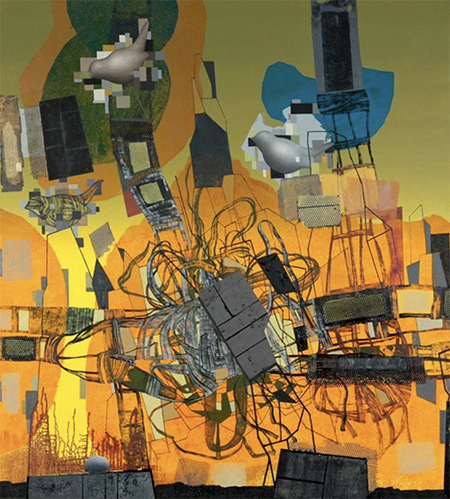
Continuing through May 19, 2023
For many, contemporary conceptual and multimedia art have eclipsed earlier notions of art as exploration, self-expression, and craftsmanship. Art, however, is large, as Walt Whitman put it; it contains contradictory impulses. The 5th-century Latin phrase, ut pictura poesis (as painting, so poetry) expressed one concept of art that has lasted millennia, and one that David Frazer claims in his essay, “On Painting as Poetry.”
The abstract painter insists on the viability of painting as a pursuit of the meaningful or evocative image through the accidents and revisions of the creative process. Shaped by both abstract expressionism and collage, as well as admiration for predecessors such as Giotto, Piero della Francesca, Cézanne, Morandi, Albert Pinkham Ryder and Philip Guston, Frazer restates the importance of the personal, the ambiguous and the true in our culture of simulacra — of mass marketing and instant gratification, or “fake news” and “alternative facts.” Frazer creates visual metaphors for complicated (and contradictory) contemporary phenomena that are highly individualistic and instantly recognizable. Paradoxically, some of these metaphors are also universal in their appeal, especially to those who have devoted the requisite time to thinking about art. The result of weeks and months of experimentation and revision, the beauty in Frazer’s paintings emerges as complex, hard-won struggles against and collaborations with impulse and accident and a sophisticated organizing intelligence able to harness and organize chaos — ad astra per aspera, to the stars through challenges.
The show, “Lyric Abstraction, Hami and Home,” presents twenty-two medium-sized oils on canvas painted between 2019 and 2023, during and immediately after the Covid-19 pandemic. The artist retired from teaching at Rhode Island School of Design and traveled to Hami, an agricultural and mining city of about 600,000 people located along the ancient Silk Road in the eastern part of China's northwestern Xinjiang Region, bordering Mongolia. Hami’s fertile landscape, famed for melons, raisins, and wine, is the subject of four paintings from 2019 with subdued beige-gray-ocher patches overlaid by motifs that recur in many works: The Ben-Day dot screen, the egg and bird, the woodcut tulip flower. All are hand-painted in black, using templates and the most exacting technique, counterfeiting the mechanically reproduced Photoshopped or silkscreened imagery that others employ. “Hami #1” and “Hami #8” represent what appear to be a landscape and a street scene, though abstracted and simplified. The illusionist window frame metaphor recurs, though flattened and juxtaposed with various graphic images, in Frazer’s nine “’Lamentations: A Covid Project” series, with their egg forms symbolizing both self-protection and potential rebirth, set amid simplified crepuscular or nocturnal landscapes.
Most typical are paintings employing the flattened perspective associated with Synthetic Cubism, when Picasso (think especially of his “Three Musicians”) and Braque brightened their color and played reality-illusion games by contrasting collage elements with painted elements. To this patchwork-grid format Frazer has added Abstract Expressionist color patches, usually restricted to the backgrounds, and simulated collage elements. It results in a hybrid style well adapted to the razzle-dazzle heterogeneity of modern life a century after the early modernists found it both exhilarating and exhausting. Frazer’s openness to pictorial disorder ensures the vitality of works like “Bird on a Wire” (2018), “Cityscape” (2019), “Lattice Towers” (2022), and “When Birds Fly” (2023). Each painting is a journey away from home — into novelty, excitement, chaos — and back again to home base.
